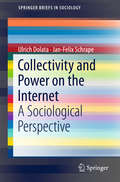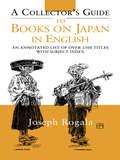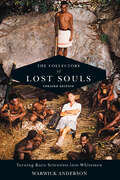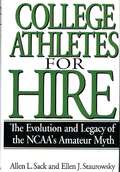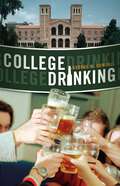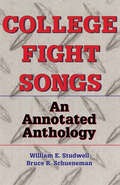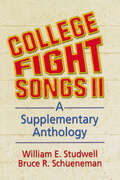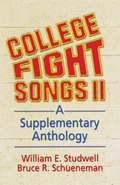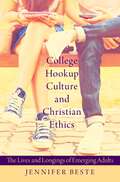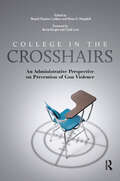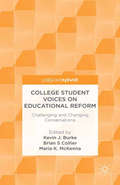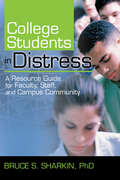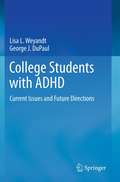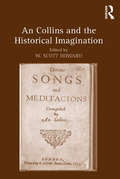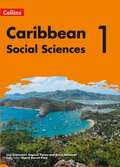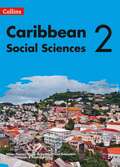- Table View
- List View
Collectivity and Power on the Internet: A Sociological Perspective (SpringerBriefs in Sociology)
by Ulrich Dolata Jan-Felix SchrapeThis book provides a comprehensive overview of the manifestations and interrelations of collectivity and power on the internet from a sociological point of view. It addresses questions on how different forms of internet-based collectivities (masses, crowds, movements, communities ) could be understood and differentiated from one another. It presents analyses on the role technical infrastructures of the web play for their formation, how the mobilization and organization of social movements and social protests has changed through social media, how work and decision-making processes are organized in open source communities and why the essential segments of the commercial internet are today concentrated in the hands of a few corporations who dispose over significant economic, infrastructural and rule-setting power.
A Collector's Guide to Books on Japan in English: An Annotated List of Over 2500 Titles with Subject Index
by Jozef RogalaProvides an invaluable and very accessible addition to existing biographic sources and references, not least because of the supporting biographies of major writers and the historical and cultural notes provided.
A Collector's Guide to Books on Japan in English: An Annotated List of Over 2500 Titles with Subject Index
by Jozef RogalaProvides an invaluable and very accessible addition to existing biographic sources and references, not least because of the supporting biographies of major writers and the historical and cultural notes provided.
The Collectors of Lost Souls: Turning Kuru Scientists into Whitemen
by Warwick AndersonWinner, William H. Welch Medal, American Association for the History of MedicineWinner, Ludwik Fleck Prize, Society for Social Studies of ScienceWinner, General History Award, New South Wales Premier's History AwardsWhen whites first encountered the Fore people in the isolated highlands of colonial New Guinea during the 1940s and 1950s, they found a people in the grip of a bizarre epidemic. Women and children succumbed to muscle weakness, uncontrollable tremors, and lack of coordination, until death inevitably supervened. Facing extinction, the Fore attributed their unique and terrifying affliction to a particularly malign form of sorcery.In The Collectors of Lost Souls, Warwick Anderson tells the story of the resilience of the Fore through this devastating plague, their transformation into modern people, and their compelling attraction for a throng of eccentric and adventurous scientists and anthropologists. Battling competing scientists and the colonial authorities, the brilliant and troubled American doctor D. Carleton Gajdusek determined that the cause of the epidemic—kuru—was a new and mysterious agent of infection, which he called a slow virus (now called a prion). Anthropologists and epidemiologists soon realized that the Fore practice of eating their loved ones after death had spread the slow virus. Though the Fore were never convinced, Gajdusek received the Nobel Prize for his discovery. Now revised and updated, the book includes an extensive new afterword that situates its impact within the fields of science and technology studies and the history of science. Additionally, the author now reflects on his long engagement with the scientists and the people afflicted, describing what has happened to them since the end of kuru. This astonishing story links first-contact encounters in New Guinea with laboratory experiments in Bethesda, Maryland; sorcery with science; cannibalism with compassion; and slow viruses with infectious proteins, reshaping our understanding of what it means to do science.
The Collectors of Lost Souls: Turning Kuru Scientists into Whitemen
by Warwick AndersonWinner, William H. Welch Medal, American Association for the History of MedicineWinner, Ludwik Fleck Prize, Society for Social Studies of ScienceWinner, General History Award, New South Wales Premier's History AwardsWhen whites first encountered the Fore people in the isolated highlands of colonial New Guinea during the 1940s and 1950s, they found a people in the grip of a bizarre epidemic. Women and children succumbed to muscle weakness, uncontrollable tremors, and lack of coordination, until death inevitably supervened. Facing extinction, the Fore attributed their unique and terrifying affliction to a particularly malign form of sorcery.In The Collectors of Lost Souls, Warwick Anderson tells the story of the resilience of the Fore through this devastating plague, their transformation into modern people, and their compelling attraction for a throng of eccentric and adventurous scientists and anthropologists. Battling competing scientists and the colonial authorities, the brilliant and troubled American doctor D. Carleton Gajdusek determined that the cause of the epidemic—kuru—was a new and mysterious agent of infection, which he called a slow virus (now called a prion). Anthropologists and epidemiologists soon realized that the Fore practice of eating their loved ones after death had spread the slow virus. Though the Fore were never convinced, Gajdusek received the Nobel Prize for his discovery. Now revised and updated, the book includes an extensive new afterword that situates its impact within the fields of science and technology studies and the history of science. Additionally, the author now reflects on his long engagement with the scientists and the people afflicted, describing what has happened to them since the end of kuru. This astonishing story links first-contact encounters in New Guinea with laboratory experiments in Bethesda, Maryland; sorcery with science; cannibalism with compassion; and slow viruses with infectious proteins, reshaping our understanding of what it means to do science.
College Athletes for Hire: The Evolution and Legacy of the NCAA's Amateur Myth (Non-ser.)
by Allen L. Sack Ellen J. StaurowskyMany books have been written on the evils of commercialism in college sport, and the hypocrisy of payments to athletes from alumni and other sources outside the university. Almost no attention, however, has been given to the way that the National Collegiate Athletic Association has embraced professionalism through its athletic scholarship policy. Because of this gap in the historical record, the NCAA is often cast as an embattled defender of amateurism, rather than as the architect of a nationwide money-laundering scheme.Sack and Staurowsky show that the NCAA formally abandoned amateurism in the 1950s and passed rules in subsequent years that literally transformed scholarship athletes into university employees. In addition, by purposefully fashioning an amateur mythology to mask the reality of this employer-employee relationship, the NCAA has done a disservice to student-athletes and to higher education. A major subtheme is that women, such as those who created the Association for Intercollegiate Athletics for Women (AIAW), opposed this hypocrisy, but lacked the power to sustain an alternative model. After tracing the evolution of college athletes into professional entertainers, and the harmful effects it has caused, the authors propose an alternative approach that places college sport on a firm educational foundation and defend the rights of both male and female college athletes. This is a provocative analysis for anyone interested in college sports in America and its subversion of traditional educational and amateur principles.
College Drinking: Reframing a Social Problem (Non-ser.)
by George W. DowdallDrinking has become recognized as one of the most important problems facing today's college student. Even though college drinking has increased only modestly over the past few decades, concern about its health, behavioral, and safety consequences has risen rapidly. This book examines college drinking as a social problem within higher education, based on interviews with many leading figures engaged in addressing the problem. It assesses the evidence about how many students drink or drink excessively, and what kinds of behavioral and health problems they have as a consequence. The book answers the crucial questions of why students drink and what mixture of personal and environmental factors shape college drinking. The complex links to campus crime and sexual assault are discussed fully. Key practical questions about effective prevention programs and countermeasures are answered in detail. Students and parents can take action to lower the risk of binge drinking by consulting an appendix, which explains how to use college guide data on 400 leading institutions or data about alcohol violations and crime available for several thousand colleges. Anyone concerned with higher education today will find a full discussion of the scope of the problem and what can be done about it.
The College Fear Factor: How Students amd Professors Misunderstand One Another
by Rebecca D. CoxThey’re not the students strolling across the bucolic liberal arts campuses where their grandfathers played football. They are first-generation college students—children of immigrants and blue-collar workers—who know that their hopes for success hinge on a degree. But college is expensive, unfamiliar, and intimidating. Inexperienced students expect tough classes and demanding, remote faculty. They may not know what an assignment means, what a score indicates, or that a single grade is not a definitive measure of ability. And they certainly don’t feel entitled to be there. They do not presume success, and if they have a problem, they don’t expect to receive help or even a second chance. Rebecca D. Cox draws on five years of interviews and observations at community colleges. She shows how students and their instructors misunderstand and ultimately fail one another, despite good intentions. Most memorably, she describes how easily students can feel defeated—by their real-world responsibilities and by the demands of college—and come to conclude that they just don’t belong there after all. Eye-opening even for experienced faculty and administrators, The College Fear Factor reveals how the traditional college culture can actually pose obstacles to students’ success, and suggests strategies for effectively explaining academic expectations.
College Fight Songs: An Annotated Anthology
by William E Studwell Bruce R SchuenemanGo, team, go! Rah, rah, rah! Boomalacka, boomalacka! Sis-boom-bah! Get your pennants and varsity colors and head for the stadium because College Fight Songs will make you an expert on the musical history of university athletic themes and anthems before the second-half kickoff. Here, in one anthology, you’ll find a unique collection of musical and historical information that hasn’t been compiled and updated since the days of Knute Rockne and the Galloping Ghost. This smart and spirited collection will give you plenty to rise and shout about, bringing together the complete lyrics, brief historical annotations, and musical scores for the songs of over 100 of the country’s most recognized colleges and universities.If you’re a researcher, librarian, musical enthusiast, band leader, musical historian, old-timer from way back when, or a young underclassmen interested in preserving a few cherished notes of your school’s history, College Fight Songs is the book for you. You’ll find plenty of hard-to-find facts about the songs and the people who inspired them, and you’ll get specific information in these areas: complete musical scores of college fight songs full lyrics of college fight songs basic historical background concerning the songs and their institutions information regarding the song creators and the college nicknamesSo, swing on the Rambling Wreck from Georgia Tech, rally around the bonfire and give a holler for the Buckeyes, the Wildcats, the Sooners, the Boilermakers, and the Tigers! The Gipper, the Bear, and Johnny U await you in this fabulous compendium of nostalgia and musical scores. Even after a few pages, College Fight Songs will have you hailing your alma mater and jumping in the car to head for the hop.
College Fight Songs: An Annotated Anthology
by William E Studwell Bruce R SchuenemanGo, team, go! Rah, rah, rah! Boomalacka, boomalacka! Sis-boom-bah! Get your pennants and varsity colors and head for the stadium because College Fight Songs will make you an expert on the musical history of university athletic themes and anthems before the second-half kickoff. Here, in one anthology, you’ll find a unique collection of musical and historical information that hasn’t been compiled and updated since the days of Knute Rockne and the Galloping Ghost. This smart and spirited collection will give you plenty to rise and shout about, bringing together the complete lyrics, brief historical annotations, and musical scores for the songs of over 100 of the country’s most recognized colleges and universities.If you’re a researcher, librarian, musical enthusiast, band leader, musical historian, old-timer from way back when, or a young underclassmen interested in preserving a few cherished notes of your school’s history, College Fight Songs is the book for you. You’ll find plenty of hard-to-find facts about the songs and the people who inspired them, and you’ll get specific information in these areas: complete musical scores of college fight songs full lyrics of college fight songs basic historical background concerning the songs and their institutions information regarding the song creators and the college nicknamesSo, swing on the Rambling Wreck from Georgia Tech, rally around the bonfire and give a holler for the Buckeyes, the Wildcats, the Sooners, the Boilermakers, and the Tigers! The Gipper, the Bear, and Johnny U await you in this fabulous compendium of nostalgia and musical scores. Even after a few pages, College Fight Songs will have you hailing your alma mater and jumping in the car to head for the hop.
College Fight Songs II: A Supplementary Anthology
by William E Studwell Bruce R SchuenemanCome join the band! College Fight Songs II is a supplement to the original College Fight Songs, providing 97 additional song texts and interesting historical information. Together they are a unique anthology of college fight songs from across the country.College Fight Songs II: A Supplementary Anthology is a second-round knockout that finishes the job started by the first edition. This rollicking continuation of the original collection will give you even more to shout about, again bringing together complete lyrics, historical annotations, and musical scores of the songs of over 50 more colleges and universities!Full of spirited music and lyrics that will put a spring in the step of incoming freshmen and music historians alike, College Fight Songs II is for you! You'll uncover plenty of behind-the-scenes info about the songs and the people who inspired them, and of course you'll find: complete musical scores full lyrics basic historical background concerning the songs and their institutions information regarding the songwriters and college nicknamesSo let&’s “Hail West Virginia,” stay “Ever True to Brown,” “Fight for LSU,” and shout out “The Buckeye Battle Cry!” College Fight Songs II will keep you in the game!
College Fight Songs II: A Supplementary Anthology
by William E Studwell Bruce R SchuenemanCome join the band! College Fight Songs II is a supplement to the original College Fight Songs, providing 97 additional song texts and interesting historical information. Together they are a unique anthology of college fight songs from across the country.College Fight Songs II: A Supplementary Anthology is a second-round knockout that finishes the job started by the first edition. This rollicking continuation of the original collection will give you even more to shout about, again bringing together complete lyrics, historical annotations, and musical scores of the songs of over 50 more colleges and universities!Full of spirited music and lyrics that will put a spring in the step of incoming freshmen and music historians alike, College Fight Songs II is for you! You'll uncover plenty of behind-the-scenes info about the songs and the people who inspired them, and of course you'll find: complete musical scores full lyrics basic historical background concerning the songs and their institutions information regarding the songwriters and college nicknamesSo let&’s “Hail West Virginia,” stay “Ever True to Brown,” “Fight for LSU,” and shout out “The Buckeye Battle Cry!” College Fight Songs II will keep you in the game!
College for Students with Disabilities: We Do Belong
by Dena Gassner Mitchell Nagler Francine Conway Anita Frey Alyssa L. Conigliaro Chanelle Tyler Best Karleen Haines Sonia Minutella Melissa Mooney Patrick Kelty Diana Damilatis Kerry Magro Ehrin McHenry Kelsey McLaughlinThis book presents a realistic picture of the positive and negative aspects of the transition to higher education as experienced by students with disabilities. It combines findings from special education studies, personal stories from individuals with disabilities, and tips for both individuals and professionals facing the challenges.
College Hookup Culture and Christian Ethics: The Lives and Longings of Emerging Adults
by Jennifer BesteToday's Christian adolescents and young adults have grown up with fiercely competing narratives about sex, relationships, and fulfillment. Within a Christian world of church services and formal religious education, they have been warned repeatedly about the dangers (or sinfulness) of premarital sex. At the same time, popular culture has inundated them with a very different message: casual sex is fun, thrilling, expected, and no big deal. Jennifer Beste calls into question the widespread assumption that the media's narrative of sex is positively liberating, while a Christian theological account is repressive, sex-negative, and altogether irrelevant. Her argument is based on a qualitative analysis of college students' own accounts of their social and sexual culture. She draws on the reflections of 126 undergraduate students who set out as sober ethnographers to observe and analyze peers at college parties. Overwhelmingly, undergraduates' perspectives challenge a neutral or even benevolent view of hookup culture embraced by some sociologists, "sex-positive" feminists, and popular culture in general. Beste goes on to share her own and her students' theological and ethical reflections as they explored the intersection between their social reality, the Christian tradition, and other academic disciplines, and sought to discern more deeply: what it means to become fully human; what constitutes happiness and fulfillment; and how to envision and create more socially and sexually just communities.
College Hookup Culture and Christian Ethics: The Lives and Longings of Emerging Adults
by Jennifer BesteToday's Christian adolescents and young adults have grown up with fiercely competing narratives about sex, relationships, and fulfillment. Within a Christian world of church services and formal religious education, they have been warned repeatedly about the dangers (or sinfulness) of premarital sex. At the same time, popular culture has inundated them with a very different message: casual sex is fun, thrilling, expected, and no big deal. Jennifer Beste calls into question the widespread assumption that the media's narrative of sex is positively liberating, while a Christian theological account is repressive, sex-negative, and altogether irrelevant. Her argument is based on a qualitative analysis of college students' own accounts of their social and sexual culture. She draws on the reflections of 126 undergraduate students who set out as sober ethnographers to observe and analyze peers at college parties. Overwhelmingly, undergraduates' perspectives challenge a neutral or even benevolent view of hookup culture embraced by some sociologists, "sex-positive" feminists, and popular culture in general. Beste goes on to share her own and her students' theological and ethical reflections as they explored the intersection between their social reality, the Christian tradition, and other academic disciplines, and sought to discern more deeply: what it means to become fully human; what constitutes happiness and fulfillment; and how to envision and create more socially and sexually just communities.
College in the Crosshairs: An Administrative Perspective on Prevention of Gun Violence
by Brandi Hephner LaBanc Brian O. HemphillGun violence – whether rampage shootings, homicides or suicides – is a potential reality all campuses have to face. This book provides leaders in higher education – and particularly those in student affairs – with data about past incidents, an analysis of trends, and background on the national debate about gun policies and how they impact colleges, state by state. It importantly raises issues about student psychological development, mental health, and the prevalence of alcohol and substance abuse on campus, to better inform discussion about allowing guns on campus and concealed carry. It concludes by sharing strategies for averting gun-related tragedies, and offering models for responding when they occur, based on lessons learned and best practices. The book addresses concealed carry legislation and its impact on campus policies by state, examining the concerns of administrators as they discharge their duty of care to students and comply with legal and regulatory frameworks. Asking “Are our students developmentally ready to make a morally sophisticated, life-changing decision to use firearms in response to a real or perceived threat?”, it offers important perspectives and scientific data, so far absent from the debate, to shape the ongoing conversation with lawmakers and the public about what it takes to keep college communities safe.In addressing risk and prevention, contributors cover the relationship between violence and mental health, and the need to establish comprehensive strategic plans and a preventative framework that promotes help-seeking for those in need before they reach the point of crisis, as well as a campus-wide risk assessment team, stressing the importance of cultivating a community-wide approach to campus safety by empowering members to report suspicious behavior. They also offer guidance on improving effective behavior intervention and case management processes.The book concludes by outlining best practices, and providing guidance on developing an emergency plan, practicing and testing systems, and creating a robust communications strategy. Individual chapters focus on how small colleges with limited resources can develop effective plans into by partnering with local agencies; as well as on the steps that community colleges – who generally lack resident advisors and residential staff, and whose students are far more dispersed – can take to diminish risk and respond promptly and professionally to a crisis.This is an essential guide for all higher education leaders concerned about preventing violence on our campuses, and a call to action.
College in the Crosshairs: An Administrative Perspective on Prevention of Gun Violence
Gun violence – whether rampage shootings, homicides or suicides – is a potential reality all campuses have to face. This book provides leaders in higher education – and particularly those in student affairs – with data about past incidents, an analysis of trends, and background on the national debate about gun policies and how they impact colleges, state by state. It importantly raises issues about student psychological development, mental health, and the prevalence of alcohol and substance abuse on campus, to better inform discussion about allowing guns on campus and concealed carry. It concludes by sharing strategies for averting gun-related tragedies, and offering models for responding when they occur, based on lessons learned and best practices. The book addresses concealed carry legislation and its impact on campus policies by state, examining the concerns of administrators as they discharge their duty of care to students and comply with legal and regulatory frameworks. Asking “Are our students developmentally ready to make a morally sophisticated, life-changing decision to use firearms in response to a real or perceived threat?”, it offers important perspectives and scientific data, so far absent from the debate, to shape the ongoing conversation with lawmakers and the public about what it takes to keep college communities safe.In addressing risk and prevention, contributors cover the relationship between violence and mental health, and the need to establish comprehensive strategic plans and a preventative framework that promotes help-seeking for those in need before they reach the point of crisis, as well as a campus-wide risk assessment team, stressing the importance of cultivating a community-wide approach to campus safety by empowering members to report suspicious behavior. They also offer guidance on improving effective behavior intervention and case management processes.The book concludes by outlining best practices, and providing guidance on developing an emergency plan, practicing and testing systems, and creating a robust communications strategy. Individual chapters focus on how small colleges with limited resources can develop effective plans into by partnering with local agencies; as well as on the steps that community colleges – who generally lack resident advisors and residential staff, and whose students are far more dispersed – can take to diminish risk and respond promptly and professionally to a crisis.This is an essential guide for all higher education leaders concerned about preventing violence on our campuses, and a call to action.
College Student Voices on Educational Reform: Challenging and Changing Conversations
by Kevin J. Burke, Brian S Collier and Maria K. McKennaThis text critically addresses, through college student voices, the American school reform movement in its rhetoric, policy, and practice. It demonstrates how university courses can be designed to treat students as engaged citizens and contextualizes students' voices in the private university and the public sphere.
College Students in Distress: A Resource Guide for Faculty, Staff, and Campus Community
by Bruce SharkinBe prepared to deal with campus situations that involve students in emotional crisisCollege Students in Distress provides college personnel with invaluable information on how to identify and refer emotionally troubled students for professional counseling. Dr. Bruce S. Sharkin, a staff psychologist at Kutztown University in Pennsylvania, addresses general warning signs of student distress, symptoms of specific psychological problems such as anxiety and depression, guidelines for interventions, and methods of making a referral for counseling. The book also examines current mental health issues for college students and provides an overview of common campus policies and procedures, such as psychological emergencies, withdrawal and readmission, and mandatory counseling. College Students in Distress provides the answers you need to manage difficult-and potentially dangerous-situations on campus. Case examples based on real-life experiences give you a clear sense of what can happen when responding to students in emotional distress, particularly when dealing with specific issues and student populations, and will help in your efforts to review and/or revise the current practices of your school. This unique book is essential as a resource and referral guide that raises awareness of this growing national problem without being limited to the characteristics of a particular college or university. Topics examined in College Students in Distress include: the impact of mental health problems on academics the roles and functions of college counseling services indicators of emotional disturbance suicidal behavior self-inflicted harm eating disorders guidelines for intervention accommodations for students with psychological disabilities and much moreCollege Students in Distress is a must-read for faculty and staff members, particularly those working in residential life, student health, and public safety, and for administrative offices within student services and student affairs.
College Students in Distress: A Resource Guide for Faculty, Staff, and Campus Community
by Bruce SharkinBe prepared to deal with campus situations that involve students in emotional crisisCollege Students in Distress provides college personnel with invaluable information on how to identify and refer emotionally troubled students for professional counseling. Dr. Bruce S. Sharkin, a staff psychologist at Kutztown University in Pennsylvania, addresses general warning signs of student distress, symptoms of specific psychological problems such as anxiety and depression, guidelines for interventions, and methods of making a referral for counseling. The book also examines current mental health issues for college students and provides an overview of common campus policies and procedures, such as psychological emergencies, withdrawal and readmission, and mandatory counseling. College Students in Distress provides the answers you need to manage difficult-and potentially dangerous-situations on campus. Case examples based on real-life experiences give you a clear sense of what can happen when responding to students in emotional distress, particularly when dealing with specific issues and student populations, and will help in your efforts to review and/or revise the current practices of your school. This unique book is essential as a resource and referral guide that raises awareness of this growing national problem without being limited to the characteristics of a particular college or university. Topics examined in College Students in Distress include: the impact of mental health problems on academics the roles and functions of college counseling services indicators of emotional disturbance suicidal behavior self-inflicted harm eating disorders guidelines for intervention accommodations for students with psychological disabilities and much moreCollege Students in Distress is a must-read for faculty and staff members, particularly those working in residential life, student health, and public safety, and for administrative offices within student services and student affairs.
College Students with ADHD: Current Issues and Future Directions
by Lisa L. Weyandt George J. DuPaulNot long ago, conventional wisdom held that ADHD was a disorder of childhood only—that somewhere during puberty or adolescence, the child would outgrow it. Now we know better: the majority of children with the disorder continue to display symptoms throughout adolescence and into adulthood. It is during the teen and young adult years that the psychological and academic needs of young people with ADHD change considerably, and clinical and campus professionals are not always sufficiently prepared to meet the challenge.College Students with ADHD is designed to bring the professional reader up to speed. The book reviews the latest findings on ADHD in high school and college students, assessment methods, and pharmacological and nonpharmacological interventions. Practical guidelines are included for helping young adults make the transition to college, so they may cope with their disorder and do as well as possible in school and social settings. Coverage is straightforward, realistic, and geared toward optimum functioning and outcomes. Among the topics featured:- Background information, from current statistics to diagnostic issues.- ADHD in high school adolescents.- ADHD in college students: behavioral, academic, and psychosocial functioning.- Assessment of ADHD in college students.- Psychosocial/educational treatment of ADHD in college students.- Pharmacotherapy for college students with ADHD.- Future directions for practice and research.The comprehensive information in College Students with ADHD provides a wealth of information to researchers and professionals working with this population, including clinical and school psychologists, school and college counselors, special education teachers, social workers, developmental psychologists, and disability support staff on college campuses, as well as allied mental health providers.
An Collins and the Historical Imagination
by W. Scott HowardThe first edited collection of scholarly essays to focus exclusively on An Collins, this volume examines the significance of an important religious and political poet from seventeenth-century England. The book celebrates Collins’s writing within her own time and ours through a comprehensive assessment of her poetics, literary, religious and political contexts, critical reception, and scholarly tradition. An Collins and the Historical Imagination engages with the complete arc of research and interpretation concerning Collins’s poetry from 1653 to the present. The volume defines the center and circumference of Collins scholarship for twenty-first century readers. The book’s thematically linked chapters and appendices provide a multifaceted investigation of An Collins’s writing, religious and political milieu, and literary legacy within her time and ours.
An Collins and the Historical Imagination
by W. Scott HowardThe first edited collection of scholarly essays to focus exclusively on An Collins, this volume examines the significance of an important religious and political poet from seventeenth-century England. The book celebrates Collins’s writing within her own time and ours through a comprehensive assessment of her poetics, literary, religious and political contexts, critical reception, and scholarly tradition. An Collins and the Historical Imagination engages with the complete arc of research and interpretation concerning Collins’s poetry from 1653 to the present. The volume defines the center and circumference of Collins scholarship for twenty-first century readers. The book’s thematically linked chapters and appendices provide a multifaceted investigation of An Collins’s writing, religious and political milieu, and literary legacy within her time and ours.
Collins Caribbean Social Sciences — STUDENT’S BOOK 1 (PDF)
by Lisa Greenstein Daphne Paizee Bruce Nicholson Cherril Barrett-FieldCollins Social Sciences for the Caribbean is a content and activity-led course set in contexts relevant to the Caribbean and suitable for lower-secondary students everywhere. It has been specially developed to help students develop the skills they need for success in social sciences. Collins Social Sciences for the Caribbean is a content and activity-led course set in contexts relevant to the Caribbean and suitable for lower-secondary students everywhere. It has been specially developed to help students develop the skills they need for success in social sciences. The course provides student's books and accompanying workbooks for Forms 1, 2 and 3 to ensure all students gain a strong foundation in social studies in preparation for their studies in the individual subjects at CSEC level.
Collins Caribbean Social Sciences — Student's Book 2 (PDF)
by Naam Thomas Nicole Philip-Dowe Lisa Greenstein Bruce Nicholson Daphne PaizeeCollins Social Sciences for the Caribbean is a content and activity-led course set in contexts relevant to the Caribbean and suitable for lower-secondary students everywhere. It has been specially developed to help students develop the skills they need for success in social sciences. Collins Social Sciences for the Caribbean is a content and activity-led course set in contexts relevant to the Caribbean and suitable for lower-secondary students everywhere. It has been specially developed to help students develop the skills they need for success in social sciences. The course provides student's books and accompanying workbooks for Forms 1, 2 and 3 to ensure all students gain a strong foundation in social studies in preparation for their studies in the individual subjects at CSEC level.
